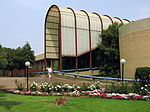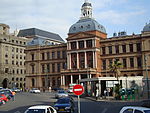Roman Catholic Archdiocese of Pretoria
1948 establishments in South AfricaAC with 0 elementsAll pages needing cleanupChristian organizations established in 1948Religious organisations based in South Africa ... and 7 more
Roman Catholic Archdiocese of PretoriaRoman Catholic Ecclesiastical Province of PretoriaRoman Catholic archbishops of PretoriaRoman Catholic dioceses and prelatures established in the 20th centuryRoman Catholic dioceses in South AfricaRoman Catholic ecclesiastical provinces in South AfricaWikipedia pages needing cleanup from July 2019
The Roman Catholic Archdiocese of Pretoria (Latin: Praetorien(sis)) is a Latin Catholic archdiocese and the Metropolitan See for the ecclesiastical province of Pretoria in South Africa. The cathedral archiepiscopal see of the Archbishop is Sacred Heart Cathedral in Pretoria.
Excerpt from the Wikipedia article Roman Catholic Archdiocese of Pretoria (License: CC BY-SA 3.0, Authors).Roman Catholic Archdiocese of Pretoria
Sophie de Bruyn Street, Pretoria Salvokop
Geographical coordinates (GPS) Address Nearby Places Show on map
Geographical coordinates (GPS)
| Latitude | Longitude |
|---|---|
| N -25.75 ° | E 28.183333333333 ° |
Address
Colorado Bottle Store
Sophie de Bruyn Street
0126 Pretoria, Salvokop
Gauteng, South Africa
Open on Google Maps








